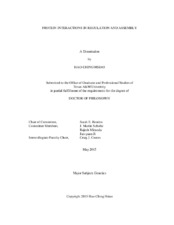| dc.description.abstract | The objectives of this work include: validation of yeast-based assays, investigation of protein-protein interactions in the regulatory role of an intrinsically disordered protein, Ultrabithorax (Ubx), and exploration of possible application of Ubx self-assemble protein materials for cell culture study.
Yeast based assays are useful for detecting DNA-protein and protein-protein interactions. Although yeast-based assays are sensitive, substantial amount of artifacts often hinder the correct interpretation of the results. The first part of the project was focused on the validation of yeast one-hybrid and two- hybrid assay and assessment for the possible source of artifacts. We found that media sources and preparation methods had significant influence on the results to yeast-one-hybrid and yeast-two hybrid assay.
Using condition optimized yeast-two hybrid assay to match in vivo experiments, we examined protein interactions formed by Ubx, a protein with intrinsically disordered regions. In the classical protein structure-function paradigm, protein function is determined by particular protein structure. However, some proteins do not have rigid structure, and these proteins extensively interact with proteins with diverse functions. The second part of this dissertation was focused on dissecting the topological features of binding partner of an intrinsically disordered protein, Ubx. We found that the binding partners of Ubx protein were enriched in particular folds and disordered regions on Ubx protein were essential for Ubx-partner protein interactions, which may explain why proteins with multiple binding partners often have disordered regions.
Ubx protein not only interacts with other proteins but also with itself. This self-association has been explored for the application for tissue engineering purposes. The cytocompatible and biocompatible characteristics of Ubx self-assemble protein materials could provide an unmet need for 3-dimensional (3D) scaffolds on which to culture cancer cells for carcinogenesis characterization. The third part of this dissertation was focused on determining the compatibility between isogenic human mammary gland cell lines with various degrees of tumorigenesis and characterization of cell behavior on Ubx materials. We found that Ubx materials were not toxic to human mammary gland cells with similar genetic background but different degree of tumorigenesis. In addition, Ubx materials enabled further characterization of cancer cell specific cell behaviors. | en |


